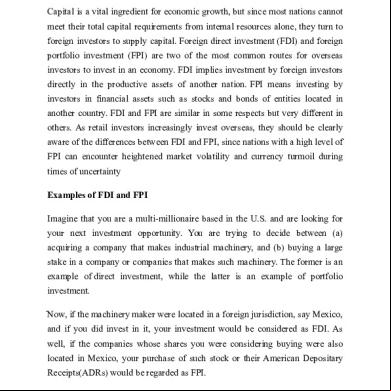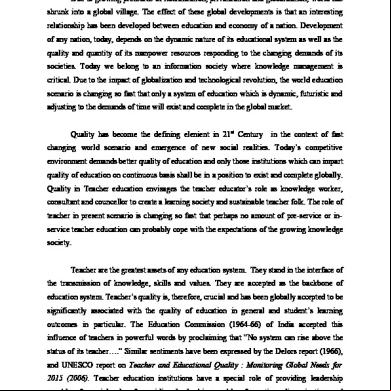This document was ed by and they confirmed that they have the permission to share it. If you are author or own the copyright of this book, please report to us by using this report form. Report 2z6p3t
Overview 5o1f4z
& View Fdi & Fpi as PDF for free.
More details 6z3438
- Words: 813
- Pages: 3
Foreign Investment Routes: The FDI And FPI Capital is a vital ingredient for economic growth, but since most nations cannot meet their total capital requirements from internal resources alone, they turn to foreign investors to supply capital. Foreign direct investment (FDI) and foreign portfolio investment (FPI) are two of the most common routes for overseas investors to invest in an economy. FDI implies investment by foreign investors directly in the productive assets of another nation. FPI means investing by investors in financial assets such as stocks and bonds of entities located in another country. FDI and FPI are similar in some respects but very different in others. As retail investors increasingly invest overseas, they should be clearly aware of the differences between FDI and FPI, since nations with a high level of FPI can encounter heightened market volatility and currency turmoil during times of uncertainty Examples of FDI and FPI Imagine that you are a multi-millionaire based in the U.S. and are looking for your next investment opportunity. You are trying to decide between (a) acquiring a company that makes industrial machinery, and (b) buying a large stake in a company or companies that makes such machinery. The former is an example of direct investment, while the latter is an example of portfolio investment. Now, if the machinery maker were located in a foreign jurisdiction, say Mexico, and if you did invest in it, your investment would be considered as FDI. As well, if the companies whose shares you were considering buying were also located in Mexico, your purchase of such stock or their American Depositary Receipts(ADRs) would be regarded as FPI. Although FDI is generally restricted to large players who can afford to invest directly overseas, the average investor is quite likely to be involved in FPI,
knowingly or unknowingly. Every time you buy foreign stocks or bonds either directly or through ADRs, mutual funds or exchange-traded funds, you are engaged in FPI. The cumulative figures for FPI are huge. Evaluating Attractiveness for FDI / FPI Because capital is always in short supply and is highly mobile, foreign investors have standard criteria when evaluating the desirability of an overseas destination for FDI and FPI, which include: Economic factors – the strength of the economy, GDP growth trends, infrastructure, inflation, currency risk, foreign exchange controls etc. Political factors – political stability, government’s business philosophy, track record, and so on. Incentives for foreign investors – taxation levels, tax incentives, property rights, etc. Other factors – education and skills of the labor force, business opportunities, local competition etc. FDI versus FPI Although FDI and FPI are similar in that they both originate from foreign investors, there are some very fundamental differences between the two. The first difference arises in the degree of control exercised by the foreign investor. FDI investors typically take controlling positions in domestic firms or t ventures, and are actively involved in their management. FPI investors, on the other hand, are generally ive investors who are not actively involved in the day-to-day operations and strategic plans of domestic companies, even if they have a controlling interest in them.
The second difference is that FDI investors perforce have to take a long-term approach to their investments, since it can take years from the planning stage to project implementation. On the other hand, FPI investors may profess to be in for the long haul but often have a much shorter investment horizon, especially when the local economy encounters some turbulence. Which brings us to the final point. FDI investors cannot easily liquidate their assets and depart from a nation, since such assets may be very large and quite illiquid. FPI investors have an advantage here in that they can exit a nation literally with a few mouse clicks, as financial assets are highly liquid and widely traded. FDI and FPI – Pros and Cons FDI and FPI are both important sources of funding for most economies. Foreign capital can be used to develop infrastructure, set up manufacturing facilities and service hubs, and invest in other productive assets such as machinery and equipment, which contributes to economic growth and stimulates employment However, FDI is obviously the route preferred by most nations for attracting foreign investment, since it is much more stable than FPI and signals longlasting commitment to an economy. But for an economy that is just opening up, meaningful amounts of FDI may only result once overseas investors have confidence in its long-term prospects and the ability of the local government. Though FPI is desirable as a source of investment capital, it tends to have a much higher degree of volatility than FPI. In fact, FPI is often referred to as “hot money” because of its tendency to flee at the first signs of trouble in an economy. These massive portfolio flows can exacerbate economic problems during periods of uncertainty.
knowingly or unknowingly. Every time you buy foreign stocks or bonds either directly or through ADRs, mutual funds or exchange-traded funds, you are engaged in FPI. The cumulative figures for FPI are huge. Evaluating Attractiveness for FDI / FPI Because capital is always in short supply and is highly mobile, foreign investors have standard criteria when evaluating the desirability of an overseas destination for FDI and FPI, which include: Economic factors – the strength of the economy, GDP growth trends, infrastructure, inflation, currency risk, foreign exchange controls etc. Political factors – political stability, government’s business philosophy, track record, and so on. Incentives for foreign investors – taxation levels, tax incentives, property rights, etc. Other factors – education and skills of the labor force, business opportunities, local competition etc. FDI versus FPI Although FDI and FPI are similar in that they both originate from foreign investors, there are some very fundamental differences between the two. The first difference arises in the degree of control exercised by the foreign investor. FDI investors typically take controlling positions in domestic firms or t ventures, and are actively involved in their management. FPI investors, on the other hand, are generally ive investors who are not actively involved in the day-to-day operations and strategic plans of domestic companies, even if they have a controlling interest in them.
The second difference is that FDI investors perforce have to take a long-term approach to their investments, since it can take years from the planning stage to project implementation. On the other hand, FPI investors may profess to be in for the long haul but often have a much shorter investment horizon, especially when the local economy encounters some turbulence. Which brings us to the final point. FDI investors cannot easily liquidate their assets and depart from a nation, since such assets may be very large and quite illiquid. FPI investors have an advantage here in that they can exit a nation literally with a few mouse clicks, as financial assets are highly liquid and widely traded. FDI and FPI – Pros and Cons FDI and FPI are both important sources of funding for most economies. Foreign capital can be used to develop infrastructure, set up manufacturing facilities and service hubs, and invest in other productive assets such as machinery and equipment, which contributes to economic growth and stimulates employment However, FDI is obviously the route preferred by most nations for attracting foreign investment, since it is much more stable than FPI and signals longlasting commitment to an economy. But for an economy that is just opening up, meaningful amounts of FDI may only result once overseas investors have confidence in its long-term prospects and the ability of the local government. Though FPI is desirable as a source of investment capital, it tends to have a much higher degree of volatility than FPI. In fact, FPI is often referred to as “hot money” because of its tendency to flee at the first signs of trouble in an economy. These massive portfolio flows can exacerbate economic problems during periods of uncertainty.








